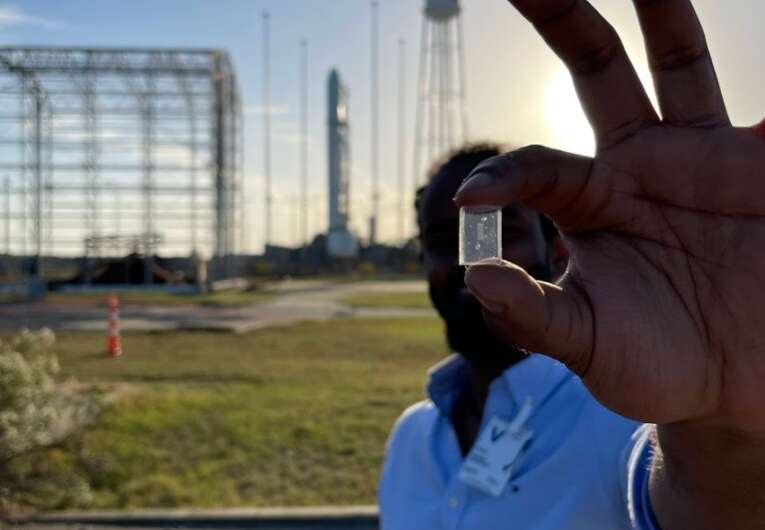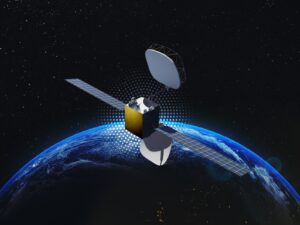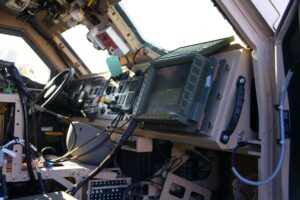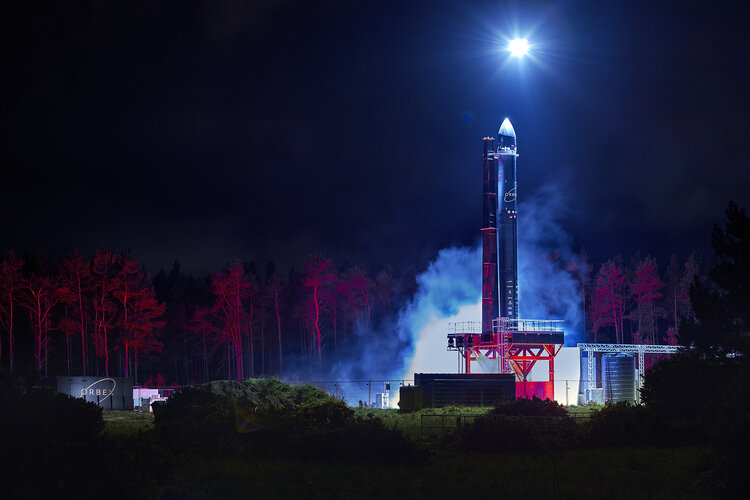Experiments to study gravity's impact on bone cells are heading to the International Space Station
Monday, 07 November 2022 20:38
A pair of experiments exploring bone density, designed by engineers at the University of Michigan, has left the Wallops Island, Virginia launchpad aboard a Northrop Grumman Corp. Antares rocket for the International Space Station (ISS).
Allen Liu, U-M associate professor of mechanical engineering, and members of his research team detail how experiments in space can shed light on osteoporosis, a condition affecting hundreds of millions of people around the world—as well as how to keep astronauts safer.
What's the connection between bone density, osteoporosis and gravity that makes this space-based research relevant to regular people?
Intelsat orders small GEO satellite from 3D printing specialist
Monday, 07 November 2022 19:34
3D printing specialist Swissto12 said Nov. 7 it has sold its first small satellite to Intelsat for a launch to geostationary orbit in 2025.
The post Intelsat orders small GEO satellite from 3D printing specialist appeared first on SpaceNews.
Inmarsat wins $410 million U.S. Army contract to connect tracking devices
Monday, 07 November 2022 18:56
Inmarsat Government won a $410 million, five-year contract extension to provide internet-of-things satellite connectivity for U.S. Army battlefield tracking devices.
The post Inmarsat wins $410 million U.S. Army contract to connect tracking devices appeared first on SpaceNews.
Zimbabwe launches first nano-satellite
Monday, 07 November 2022 18:45Zimbabwe on Monday announced the launch of its first nano-satellite into space in a bid to help collect data to monitor disasters, boost agriculture and enhance mineral mapping.
A rocket carrying the tiny satellite, dubbed ZIMSAT-1, successfully launched from Virginia in the United States alongside Uganda's first satellite as part of the Japan Aerospace Exploration Agency (JAXA) multi-nation project.
"History unfolding.#ZimSat1 now space bound!" government spokesman Nick Mangwana wrote in a tweet. "This is a scientific milestone for the country."
The US National Aeronautics and Space Administration (NASA) tweeted Monday the rocket "will carry experiments about plant mutations and mudflow structure, as well as satellites from Japan, Uganda & Zimbabwe".
Zimbabwe's plans to launch the satellite started in 2018, less than a year after President Emmerson Mnangagwa came into office following the removal of veteran ruler Robert Mugabe through a military coup.
He created the Zimbabwean National Geospatial and Space Agency (ZINGSA) to promote research and innovation in the embattled southern African nation.
The launch of the satellite—barely the size of a shoebox—sparked much debate on social media with some hailing the government for the achievement while others mocked the effort.
"Launching a satellite when the economy is fragile is stupidity.
Solar panel trouble on cargo capsule bound for space station
Monday, 07 November 2022 18:44
A Northrop Grumman cargo capsule ran into trouble with a solar panel after Monday's liftoff to the International Space Station.
Only one of the two solar panels on the Cygnus capsule opened successfully following the predawn liftoff from Virginia.
Northrop Grumman officials assured NASA that there's enough power from the solar panel for Wednesday's planned space station rendezvous, but the space agency was still assessing the situation.
It's too early to know whether the capsule would be stable enough to be captured by the space station's robot arm, if the problem persists, said NASA's Dina Contella, a space station manager.
Northrop Grumman launched the capsule from coastal Wallops Island with more than 8,200 pounds of equipment and experiments, including brackets needed for upcoming spacewalks to upgrade the space station's power grid. It's dubbed the S.S. Sally Ride after the first American woman in space who died a decade ago.
The Virginia-based company has been sending shipments to the space station since 2013. There's been only one failure in its previous 18 supply runs, a launch explosion in 2014.
SpaceX is NASA's other contracted delivery service.
Space Force official: We need the Commerce Department’s space traffic office to be successful
Monday, 07 November 2022 18:28
Maj. Gen. DeAnna Burt said discussions between DoD and the Department of Commerce are picking up momentum as both agencies work to figure out how to transition space traffic management to the Office of Space Commerce.
Measuring sunlight from space, on a chip
Monday, 07 November 2022 16:34
For 40 years, people have used space-based sensors to measure the amount of light coming from the sun, which gives scientists insight into climate change on Earth.
Most of the energy powering Earth's climate system comes from sunlight. So, if scientists measure the energy hitting Earth from the sun, and also measure the energy leaving Earth, then they can determine how much energy remains behind.
Scientists measure the sunlight reaching Earth from space. The quantity they are measuring—called the "total solar irradiance" (TSI)—includes all the energy from all the different wavelengths of light coming out of the sun, from ultraviolet through visible and into infrared.
However, the devices currently being used to monitor the TSI are comparatively expensive to build and launch.
Antares launches Cygnus cargo mission to ISS
Monday, 07 November 2022 10:15
A Northrop Grumman Cygnus cargo spacecraft is on its way to the International Space Station after a successful launch Nov. 7 on the next-to-last flight of the current version of the company’s Antares rocket.
Ticket to ride with Boost!
Monday, 07 November 2022 10:00
In line with global trends, the European space transportation sector is under transformation – with more and more commercial actors taking the entrepreneurial challenge of proposing, developing and operating new services under private leadership. Acknowledging that a thriving commercial space transportation sector is of benefit to Europe, ESA is actively fostering new European privately-led space transportation services through its
NASA rolls Moon rocket out to Kennedy Space Center launch pad
Monday, 07 November 2022 09:38 NASA rolled out its largest-ever rocket to a launch pad in Florida on Friday and will try again 10 days from now to blast off on a much-delayed uncrewed mission to the Moon.
After two launch attempts were scrubbed this summer because of technical problems, the rocket returned to the Vehicle Assembly Building to protect it from Hurricane Ian.
The US space agency used the time to carry out
NASA rolled out its largest-ever rocket to a launch pad in Florida on Friday and will try again 10 days from now to blast off on a much-delayed uncrewed mission to the Moon.
After two launch attempts were scrubbed this summer because of technical problems, the rocket returned to the Vehicle Assembly Building to protect it from Hurricane Ian.
The US space agency used the time to carry out RDARS Eagle Nest Autonomous Drone-In-a-Box solution supports SpaceX Starlink Satellite Communications
Monday, 07 November 2022 09:38 RDARS Inc. (CSE: RDRS) (OTCQB: RDRSF), an autonomous robotics and drone technology company developing advanced systems for alarm system augmentation and surveillance, is pleased to announce its successful integration of the SpaceX Starlink High Speed internet services into its Eagle Nest Drone-in-a-Box product.
This achievement provides RDARS with a unique Eagle Watch data transmission pla
RDARS Inc. (CSE: RDRS) (OTCQB: RDRSF), an autonomous robotics and drone technology company developing advanced systems for alarm system augmentation and surveillance, is pleased to announce its successful integration of the SpaceX Starlink High Speed internet services into its Eagle Nest Drone-in-a-Box product.
This achievement provides RDARS with a unique Eagle Watch data transmission pla How magnetism could help explain Earth's formation
Monday, 07 November 2022 09:38 There are several theories about how the Earth and the Moon were formed, most involving a giant impact. They vary from a model where the impacting object strikes the newly formed Earth a glancing blow and then escapes, through to one where the collision is so energetic that both the impactor and the Earth are vaporized.
Now scientists at the University of Leeds and the University of Chicag
There are several theories about how the Earth and the Moon were formed, most involving a giant impact. They vary from a model where the impacting object strikes the newly formed Earth a glancing blow and then escapes, through to one where the collision is so energetic that both the impactor and the Earth are vaporized.
Now scientists at the University of Leeds and the University of Chicag World's first optical atomic clock with highly charged ions
Monday, 07 November 2022 09:38 Highly charged ions are a common form of matter in the cosmos, where they are found, for example, in the sun or other stars. They are so called because they have lost many electrons and therefore have a high positive charge. This is why the outermost electrons are more strongly bound to the atomic nucleus than in neutral or weakly charged atoms. For this reason, highly charged ions react less st
Highly charged ions are a common form of matter in the cosmos, where they are found, for example, in the sun or other stars. They are so called because they have lost many electrons and therefore have a high positive charge. This is why the outermost electrons are more strongly bound to the atomic nucleus than in neutral or weakly charged atoms. For this reason, highly charged ions react less st NASA fieldwork studies signs of climate change in Arctic boreal regions
Monday, 07 November 2022 09:38 From the window of a NASA Gulfstream III research aircraft, Alaska looks like a pristine wilderness untouched by humans. The land is covered in lush, green vegetation and dotted with bright blue lakes. Snow-capped mountains reach toward the sky, and chocolate milk-colored rivers snake across the landscape. The obvious signs of human activity - cities, roads, infrastructure - are hard to spot.
From the window of a NASA Gulfstream III research aircraft, Alaska looks like a pristine wilderness untouched by humans. The land is covered in lush, green vegetation and dotted with bright blue lakes. Snow-capped mountains reach toward the sky, and chocolate milk-colored rivers snake across the landscape. The obvious signs of human activity - cities, roads, infrastructure - are hard to spot. Geophysicist Leigh Royden looks at Earth from the top down
Monday, 07 November 2022 09:38 The German Academy of Sciences Leopoldina has counted some of the greatest scientists in history among its ranks. Founded in 1652, and named in honor of the Holy Roman Emperor Leopold I, the scientific organization has included among its members Marie Curie, Albert Einstein, Alexander von Humboldt, and Charles Darwin, to name a few.
But when Department of Earth, Atmospheric and Planetary S
The German Academy of Sciences Leopoldina has counted some of the greatest scientists in history among its ranks. Founded in 1652, and named in honor of the Holy Roman Emperor Leopold I, the scientific organization has included among its members Marie Curie, Albert Einstein, Alexander von Humboldt, and Charles Darwin, to name a few.
But when Department of Earth, Atmospheric and Planetary S 
